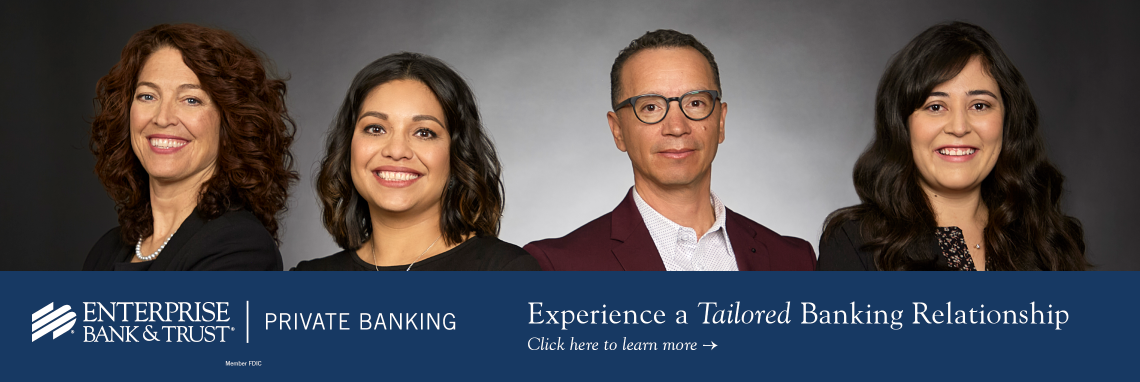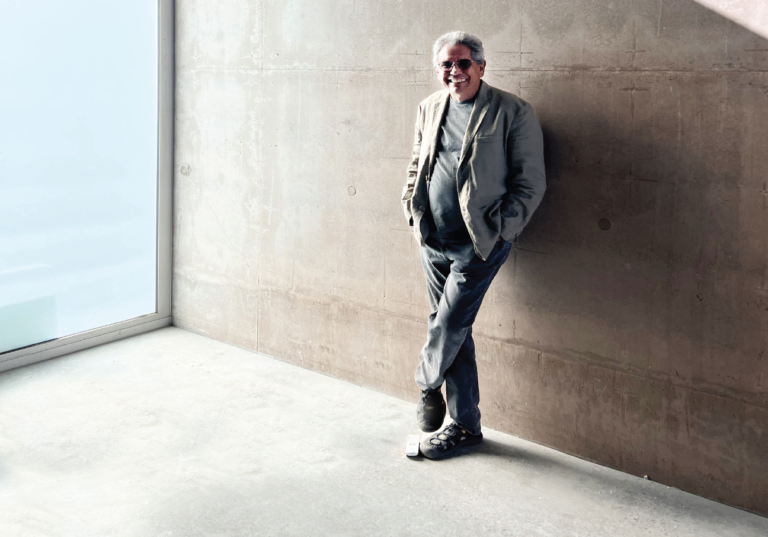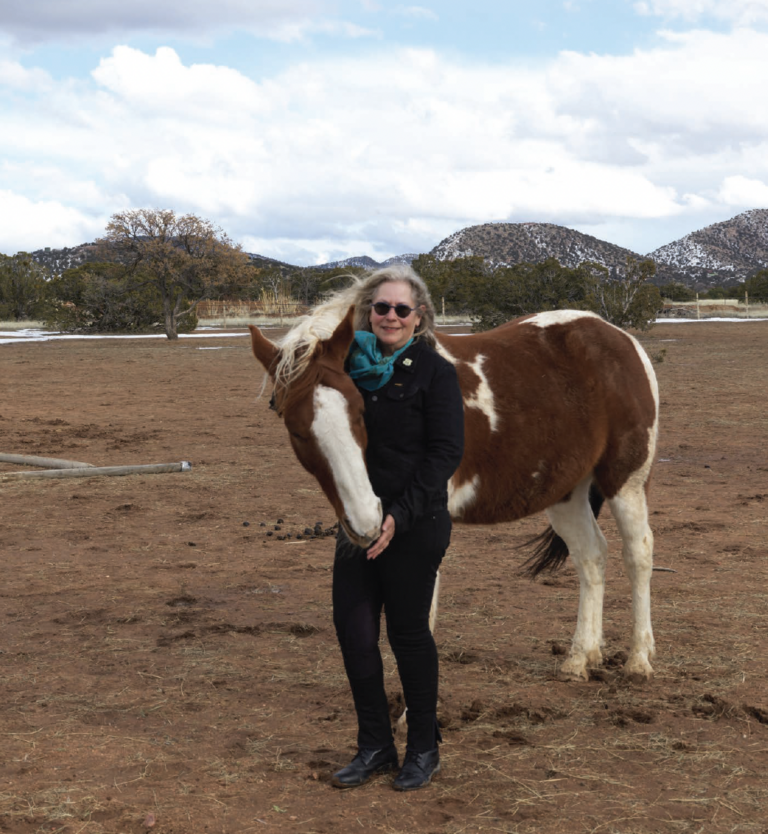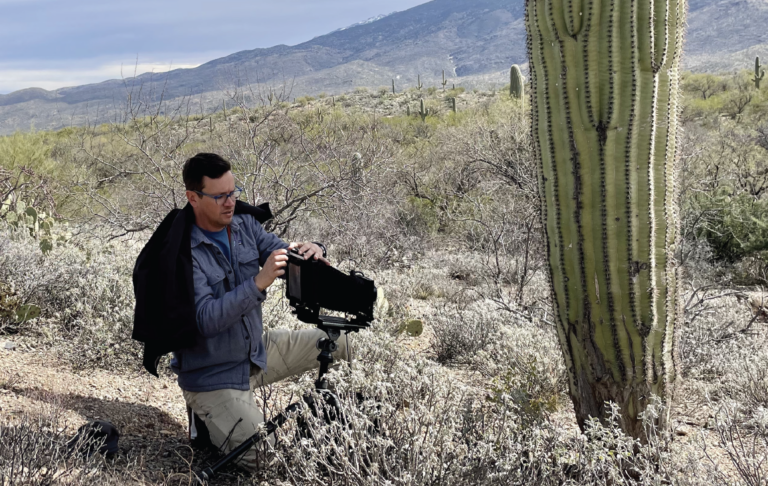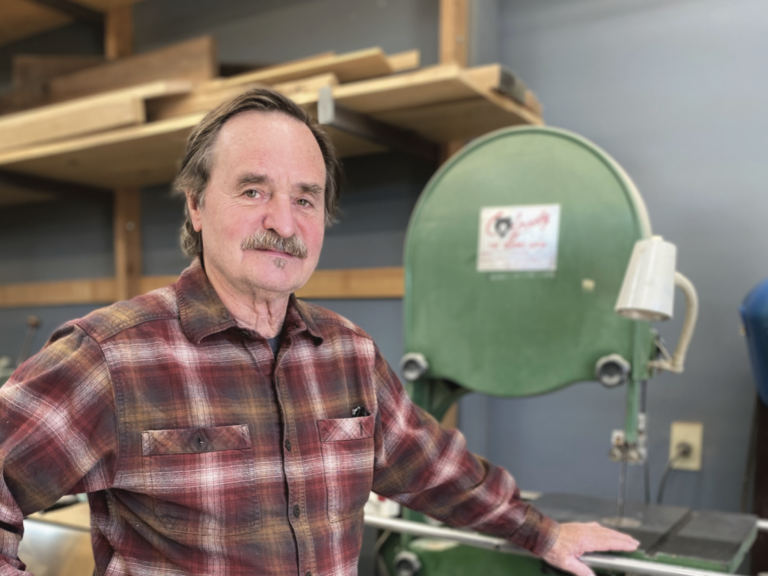IT TOOK SIX HOURS TO GET TO GILA, NM. In the last hour, there is a contiguous set of snarly switchbacks over a narrow mountain pass. I didn’t see one car for 20 miles, which was a very good thing since I found it hard to keep my eyes off the vistas, rock ledges and drop-dead canyons.
Eric wasn’t at his house when I got there, but I located him in one of the greenhouses. He was crouching along a row of startlingly red radishes. I ate two as we made our way to his kitchen. I had never tasted anything like them!
The house is straw bale – cool in the summer, warm in the winter. We had a home cooked meal, fresh from his garden. He apologized for not serving his own chicken, saying he no longer raised chickens. I had seconds.
When I photograph our interviewees, I ask the subjects to sit as still as possible. This turned out to be a very tough assignment for Eric. He couldn’t sit still because he had a shitload of stuff to get done. I took 250 pictures to finally get the ones you’re looking at.
I watched him work. He was deliberate, economic, nothing repetitive, everything paced, no stops. He’s been doing just this, every year for the last 24 years. He seems content.
How did you get into farming?
I was living in Santa Cruz in my twenties, working as a landscaper and got hired by a guy who became my mentor. His own dream was to buy a piece of land and build a homestead, but he never did it. Hearing him talk about it, I realized this my dream of how I wanted to live the rest of my life. So, I moved down to Gila and apprenticed with a farmer who was growing for an heirloom seed company. He was a pioneer. I worked for free the first year and for three dollars an hour the next, learning about every kind of plant that could grow here, from flowers to herbs to vegetables to seeds to grains.
What about heirloom seeds?
Heirlooms have been bred by people for thousands of years, choosing the best and biggest seeds and the biggest head, stabilized over generations of selective breeding. When you grow a hybrid seed, you cannot get a true variety. The heirloom companies save what varieties they can, but still there’s been tons that go extinct. That’s the crime that a company like Monsanto does, just a total disregard for all that Native peoples did year after year. Today there’s very little corn you can find anymore that hasn’t been crossed with Monsanto’s. And most commercial seeds are bred to exist in a zone where you’ve sprayed all the weeds with pesticides and fungicides. If you tried to grow these crops out in a place like this, they’d be devastated.
These plants today have weakened resistance to insects and diseases; like if you were taking antibiotics all the time and then you stopped, you would have a pretty weakened immune system. Plus, the crops at the grocery store are made for shipping and for looks, not flavor and nutrition. They taste like garbage! But if you’re serving a local community, you don’t have to ship it that far, so you can have these beautiful, tasty, nutritious foods and you’re only driving them to your local market.
What was your original dream for doing this?
A sense of being independent, self-sufficient, good water, clean air, and being able to grow your own food. Because, I mean, we’re heading for a very dire situation. I wanted to have a place to weather the obvious storm that’s coming. I’m not doing this because I want to be the last person alive or anything! If I can help you, if I can help others, I would love to help others not go hungry. But from listening to prophecy, scientists, and scripture, they all say we’re heading in this direction and there’s really nothing we’re going to do to stop it.
How are you seeing that play out right now?
In the 25 years that I’ve been here, I’ve seen profound changes. Incremental and slow at first, but now you can see it speeding up exponentially. It used to be the Farmers Market would end on Halloween and start in May because we had no opportunity to grow in winter. Winter mornings could be five or ten degrees below zero and that would kill everything. But now I can grow lettuce, carrots, turnips, spinach year-round, and the Farmer’s Market goes all year.
That’s the good news and that’s the bad news.
Well, it was nice having a break in the winter! But what I’m seeing happening is that it’s going to switch, so I’ll be able to grow in the winter, but I will not be able to grow in the summer. Last year it was 105 degrees for almost two months here, and it’s simple fact that you just cannot work outside when it’s over a 100 degrees for very long. I had a headache all summer, and just couldn’t drink enough water.
It stresses the plants, so either the bugs take advantage of the stress and it kills them, or they just downright die from funguses and disease. I’m having to use more UV and heat protection – greenhouse plastic or shade cloth, or the drip systems – which are made out of plastic where there’s no system in place around here to recycle any of that, so I’m constantly contributing to the problem I’m trying to solve. Plus, the winds have always been bad here, but now they just have this certain violence to them that just really is hard on everything.
I was watching a show about a Hopi elder, ninety-something years old, and he said, All it is is wind now. No rain. Nothing gentle. It’s just wind, wind, wind drying out crops. I think we’re just going to get blown off the face of the earth. But look at the Hopi and Navajo growing corn and sand in the desert for a thousand years with only rainwater.
Well, you have water here, this beautiful stream right in your backyard.
We have one of the most untouched rivers in North America. The source is the Mogollon Mountains and there’s a spring called Bead Springs. They called it that because the Apaches just left an altar of beads they made. And that was basically the source of the Gila River. Like everywhere in the West, you have to buy water rights, for about $10,000 an acre. And that gives you permission to
water one acre of land. Of course, it’s really hard to find land because the mines came in the 50s and bought up thousands of acres of farmland for the water rights. A lot of the land is rented now, from mine to ranchers’.
Mining is just a necessary evil at this point, used for every solar panel, for every electric car, for every bit of electronics we use. I heard someone talking the other day that we have so many sacrifice zones for industry now, whether it’s a landfill or Superfund sites from military establishments or just mining. The National Academy of Sciences labels the Four Corners region– the ancestral home of the Hopi and Diné– a national sacrifice area, the center of the most intense energy development in the United States. It’s like everything’s becoming a sacrificial zone.
It’s sobering to hear this from somebody who is doing what you’re doing.
The reason I say it with such passion is not to spread doom and gloom, it’s because no one’s talking about it enough. It’s almost like everyone’s in total denial, like climate change isn’t even a problem anymore.
As a small farmer you have a lot of worries. How do you keep your spirits up?
I’ve traveled to India five times to an ashram in Kerala to see to see a woman named Amma who’s considered to be a living saint. Getting a blessing, darshan,
from a saint is usually a connection from eye contact to devotees and disciples, but Amma actually physically hugs you. She has hugged millions and millions and millions of people and put a little part of herself in each person. She’s invoking the universal mother in a world that right now really needs a huge boost of feminine energy. She’s basically got an army of people trying their best to do good for this world, planting trees, helping the homeless, feeding people, picking up garbage. She’s got orphanages, she’s got colleges. They just built the biggest hospital in India, in Delhi, and it’s all on a sliding scale. If you have money, you get charged, but if you don’t, you still get care. If you look at the humanitarian projects Amma is doing, it’s phenomenal, and that’s just one person who grew up poverty-stricken in a fishing village.
People often think of spirituality as something ethereal. But here you are, hands in the dirt, every damn day.
All we really have is spirituality. The material world will never give us what we’re trying to get from it, will never have the ability to give us what we’re really seeking. But we still just think that if we buy one more thing, it’ll fill us up. Fill that hole in ourselves. But it never can, never has, never will.
A spiritual life is all about providing some service to the community you live in and helping people have a better life in the place you live. So if I’m providing food that doesn’t cause cancer, I hope I’m doing a service and making a living at the same time.
What are the economics of a small farm?
The big industrial food system is subsidized, so food’s not worth very much. You go to Walmart and there’s a cabbage for $2.50. But a cabbage takes a long time to grow and it takes a lot of room. I could never sell a head of cabbage for $2.50. If you live near a prosperous community like Santa Fe you can do really well in organic farming. People will pay. But here it’s an economically depressed area. I did get some grants through the Farm Bill. But there’s not even a close comparison to what factory farming gets.
Why?
After the Depression and Dust Bowl, the government said, get big or get out. They pushed us small farmers out. And the propaganda has always been, you can’t feed this nation with small farms. But in India they’re feeding that huge population with small farms. So there’s no reason why we couldn’t.
With big ag, most of what they’re growing is feed for pigs and cows and chickens, when you come down to it. And processed food. Cereals, chips, snacks, the stuff giving everyone diabetes and heart disease and cancer. That’s what the factory industrial agriculture is growing. They’re not feeding the nation, they’re really just killing the nation.
WANT TO READ MORE? SUBSCRIBE TO SANTA FE MAGAZINE HERE!
Photo SFM

